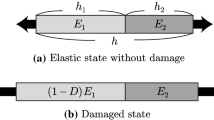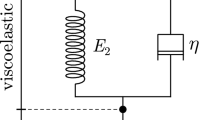Abstract
We present a new method to model fracture of concrete based on energy minimisation. The concrete is considered on the mesoscale as composite consisting of cement paste, aggregates and micro pores. In this first step, the alkali-silica reaction is taken into account through damage mechanics though the process is more complex involving thermo-hygro-chemo-mechanical reaction. We use a non-local damage model that ensures the well-posedness of the boundary value problem (BVP). In contrast to existing methods, the interactions between degrees of freedom evolve with the damage evolutions. Numerical results are compared to analytical and experimental results and show good agreement.
Similar content being viewed by others
References
Bazant Z P, Belytschko T. Wave propagation in a strain-softening bar: exact solution. Journal of Engineering Mechanics, 1985, 111(3): 381–389
Bazant Z, Jirasek M. Non-local integral formulations of plasticity and damage: survey of process. Journal of Engineering Mechanics, 2002, 128(1): 1119–1149
Babuška I, Melenk I. Partition of unity method. International Journal for Numerical Methods in Engineering, 1997, 40(4): 727–758
Belytschko T, Black T. Elastic crack growth in finite elements with minimal remeshing. International Journal for Numerical Methods in Engineering, 1999, 45(5): 601–620
Strouboulis T, Babuška I, Copps K. The design and analysis of the generalized finite element method. Computer Methods in Applied Mechanics and Engineering, 2000, 181(1–3): 43–69
Rabczuk T, Bordas S, Zi G. A three-dimensional meshfree method for continuous crack initiation, nucleation and propagation in statics and dynamics. Computational Mechanics, 2007, 40(3): 473–495
Bordas S, Rabczuk T, Zi G. Three-dimensional crack initiation, propagation, branching and junction in non-linear materials by an extended meshfree method without asymptotic enrichment. International Journal of Solids and Structures, 2008, 75(5): 943–960
Bordas S, Duflot M, Le P. A simple a posteriori error estimator for the extended finite element method. Communications in Numerical Methods in Engineering, 2008, 24: 961–971
Stratonovitch R L. Derivation of irreversibility of thermodynamic processes from microscopic reversibility. Theoretical and Mathematical Physics, 1978, 36(1): 607–616
Simo J C, Hughes T J R. Computational Inelasticity. New York: Springer-Verlag, 1998, vol 7.
Bažant Z P, Jirásek M. Nonlocal integral formulations of plasticity and damage: survey of progress. Journal of Engineering Mechanics, 2002, 128(11): 1119
Francfort G A, Marigo J J. Revisiting brittle fracture as an energy minimisation problem. Journal of the Mechanics and Physics of Solids, 1998, 46(8): 1319–1342
Dunant C, Vinh P N, Belgasmia M, Bordas S, Guidoum A. Architecture tradeoffs of integrating a mesh generator to partition of unity enriched object-oriented finite element software. Revue Européenne de Mécanique Numérique, 2007, 16(2): 237–258
Bordas S, Nguyen V P, Dunant C, Nguyen-Dang H, Guidoum A. An extended finite element library. International Journal for Numerical Methods in Engineering, 2007, 71(6): 703–732
Ponce J M, Batic O R. Different manifestations of the alkali-silica reaction in concrete according to the reaction kinetics of the reactive aggregate. Cement and Concrete Research, 2006, 36(6): 1148–1156
Ben Haha M, Gallucci E, Guidoum A, Scrivener K L. Relation of expansion due to alkali silica reaction to the degree of reaction measured by sem image analysis. Cement and Concrete Research, 2007, 37(8): 1206–1214
Dunant C F, Scrivener K L. Micro-mechanical modelling of alkali silica-reaction-induced degradation using the amie framework. Cement and Concrete Research, 2010, 4(4): 517–525
Kawamura M, Iwahori K. Asr gel composition and expansive pressure in mortars under restraint. Cement and Concrete Composites, 2004, 26(1): 47–56
Author information
Authors and Affiliations
Corresponding author
Rights and permissions
About this article
Cite this article
Dunant, C.F., Bordas, S.P.A., Kerfriden, P. et al. An Algorithm to compute damage from load in composites. Front. Archit. Civ. Eng. China 5, 180–193 (2011). https://doi.org/10.1007/s11709-011-0107-9
Received:
Accepted:
Published:
Issue Date:
DOI: https://doi.org/10.1007/s11709-011-0107-9




